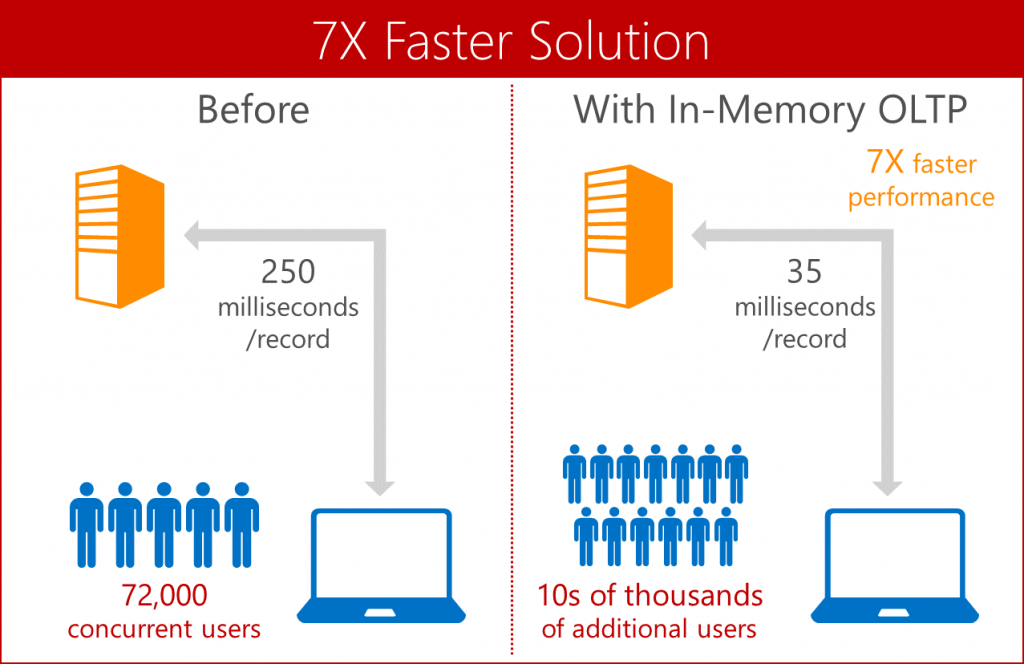Data has become increasingly critical to businesses, so it’s more important than ever for every organization to be utilizing a modern data platform that drives innovation, delivers business value and provides quick insight. In just under six months—on April 12, 2016, to be exact—extended support for SQL Server 2005 ends. That means an end to supportability updates, and perhaps more importantly, security updates.
In the decade since SQL Server 2005 launched, businesses technology needs have changed dramatically. Microsoft has responded with advancements in technology to meet and exceed the expectations of organizations large and small. Our current version, SQL Server 2014, opens the door to new scenarios with:
- Improved performance. SQL Server 2014 has benchmarked 13x faster performance than SQL Server 2005 and set a new world record for SAP performance for 16 processors on an HP Superdome X.
- In-memory across workloads for up to 30x transactional performance gains and over 100x faster queries to work with larger quantities of data and get the fast answers you need.
- High availability using AlwaysOn availability groups for mission-critical uptime and disaster recovery to the cloud for improved business continuity.
- Tools to manage data across the enterprise such as master data services, data quality services, and enhanced integration services.
- Support for unstructured, complex and streaming data to help with tasks like collecting and managing manufacturing sensor data or analyzing social media activity.
- Faster time to insight using Microsoft Excel and Power BI to meet demands for quick reporting and mobile insights.
In short, SQL Server 2014 delivers a high-performing, advanced data platform that keeps up with modern business needs. Let me share with you one customer’s story – TPP – and how they have benefitted from SQL Server 2014.
SQL Server 2014 boosts performance for clinical software company
The story is a real-world example of how SQL Server 2014 solved a number of issues for this clinical software provider. When TPP needed to increase its application’s scalability and performance to prepare for ambitious global expansion, they began planning for an upgrade that would support the company’s SystmOne clinical software application. SystmOne manages more than 30 million patient records and is used by physicians and other health professionals across England to accurately and securely document every appointment, medication, allergy and physician contact a patient has ever had.
A feature that became a critical component of the application’s success is the in-memory online transaction processing (OLTP) solution in SQL Server 2014. This high-performance, memory-optimized solution relies on no-locking/no-latching concurrency control, which serves to eliminate system bottlenecks resulting from scaling needs to handle additional users.
Using in-memory OLTP in SQL Server 2014 in testing, TPP saw seven times faster processing performance for SystmOne and the ability to scale to handle hundreds of thousands of additional users. The company expects to save time and money by not having to create its own database system. Plus, the doctors using the apps will be better equipped to serve patients with a more modern data platform supporting the critical health data being collected.
Immediate cost and security benefits
According to a July 2014 Microsoft-commissioned study with Forrester on the Total Economic Impact of SQL Server 2012 and 2014, customers realize a 9.5 month payback period when deploying a new SQL Server database. If you are running Windows Server 2003 as well as SQL Server 2005, an investment in both your infrastructure and your database technology will ensure you realize the maximum benefits of a truly modern platform by taking advantage of new security features like Windows Server Core support or the ability to scale up to 640 logical processors on Windows Server 2012 R2.
Continuing to operate SQL Server 2005 without security updates and hotfixes from Microsoft may put your organization at risk for business disruptions, security and compliance issues, and increased maintenance costs. Upgrading to SQL Server 2014 before extended support ends next April is not only a necessary security and compliance decision, but a sound business decision as well.
Watch for upcoming posts on the SQL Server blog where we’ll dive deeper into the process for planning your upgrade and offer tips and tools to ease the process. In the meantime, please visit the Microsoft SQL Server 2005 upgrade website for helpful evaluation and planning resources. We also have a worldwide team of partners and Microsoft services offerings designed to help you with your migration.
Finally, I hope you’ll also check out the Top 10 reasons to upgrade from SQL Server 2005 blog as a further resource for understanding how modernizing your data platform on SQL Server 2014 will help drive innovation, deliver business value and provide quick insight.
-Takeshi

